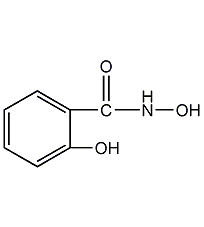
Structural formula
| Business number | 0218 |
|---|---|
| Molecular formula | C7H7NO3 |
| Molecular weight | 153.14 |
| label |
salicyloxamic acid, N,2-dihydroxybenzamide, O-Hydroxybenzoyl Hydroxamic Acid, 2-Hydroxybenzohydroxamic acid, N,2-Dihydroxybenzamide, HOC6H4CONHOH |
Numbering system
CAS number:89-73-6
MDL number:MFCD00002110
EINECS number:201-934-3
RTECS number:VO6870000
BRN number:1210520
PubChem number:24899684
Physical property data
1. Properties: White needle-like crystals. Gradually turns red in the air. Can sublime
2. Density (g/mL, 25/4℃): 1.680
3. Relative vapor density (g/mL, air=1): Undetermined
3. p>
4. Melting point (ºC): 168℃ (slow heating), 176~178℃ (rapid heating).
5. Boiling point (ºC, normal pressure): Not determined
6. Boiling point (ºC, 5.2kPa): Undetermined
7. Refractive index: Undetermined
8. Flash point (ºC): Undetermined
9. Specific rotation (º): Undetermined
10. Autoignition point or ignition Combustion temperature (ºC): Undetermined
11. Vapor pressure (kPa, 25ºC): Undetermined
12. Saturated vapor pressure (kPa, 60ºC): Undetermined
13. Heat of combustion (KJ/mol): Undetermined
14. Critical temperature (ºC): Undetermined
15. Critical pressure (KPa): Undetermined
16. Logarithmic value of oil-water (octanol/water) partition coefficient: Undetermined
17. Explosion upper limit (%, V/V): Undetermined
18. Lower explosion limit (%, V/V): Undetermined
19. Solubility: Easily soluble in ethanol and ether, soluble in hot acetic acid, slightly soluble in water.
Toxicological data
Acute toxicity:
Oral LD50 5000 mg/kg (rat)
Main irritant effects:
On the skin: Irritation to skin and mucous membranes .
On eyes: Irritation effects
Sensitization: No known sensitizing effects.
Ecological data
General Notes
Water Hazard Level 1 (German Regulation) (Adopted List��Carry out self-assessment) This substance is slightly hazardous to water.
Do not allow undiluted or large amounts of product to come into contact with groundwater, waterways or sewage systems.
Do not discharge materials into the surrounding environment without government permission.
Molecular structure data
1. Molar refractive index: 38.65
2. Molar volume (cm3/mol ): 109.2
3. Isotonic specific volume (90.2K): 312.3
4. Surface tension (dyne/cm): 66.9
5. Polarizability (10-24cm3): 15.32
Compute chemical data
1. Reference value for hydrophobic parameter calculation (XlogP): None
2. Number of hydrogen bond donors: 3
3. Number of hydrogen bond acceptors: 3
4. Number of rotatable chemical bonds: 1
5. Number of tautomers: 17
6. Topological molecule polar surface area 69.6
7. Number of heavy atoms: 11
8. Surface charge: 0
9. Complexity: 149
10. Number of isotope atoms: 0
11. Determine the number of atomic stereocenters: 0
12. Uncertain number of atomic stereocenters: 0
13. Determine the number of chemical bond stereocenters: 0
14. Number of uncertain chemical bond stereocenters: 0
15. Number of covalent bond units: 1
Properties and stability
None
Storage method
This product should be sealed and stored in a cool place away from light.
Synthesis method
None
Purpose
Organic reagents. Analyze bismuth, copper, nickel and lead, and also precipitate silver, cadmium, cobalt, iron, mercury, magnesium, manganese and vanadium.


